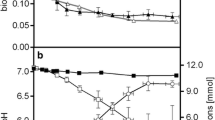Abstract
Growth of Pseudomonas putida B2 in chemostat cultures on a mixture of 3-nitrophenol and glucose induced 3-nitrophenol and 1,2,4-benzenetriol-dependent oxygen uptake activities. Anaerobic incubations of cell suspensions with 3-nitrophenol resulted in complete conversion of the substrate to ammonia and 1,2,4-benzenetriol. This indicates that P. putida B2 degrades 3-nitrophenol via 1,2,4-benzenetriol, via a pathway involving a hydroxylaminolyase. Involvement of this pathway in nitroaromatic metabolism has previously only been found for degradation of 4-nitrobenzoate.
Reduction of 3 nitrophenol by cell-free extracts was strictly NADPH-dependent. Attempts to purify the enzymes responsible for 3-nitrophenol metabolism were unsuccessful, because their activities were extremely unstable. 3-Nitrophenol reductase was therefore characterized in cell-free extracts. The enzyme had a sharp pH optimum at pH 7 and a temperature optimum at 25°C. At 30°C, reductase activity was completely destroyed within one hour, while at 0°C, the activity in cell-free extracts was over 100-fold more stable. The Km values for NADPH and 3-nitrophenol were estimated at 0.17 mM and below 2 μM, respectively. The substrate specificity of the reductase activity was very broad: all 17 nitroaromatics tested were reduced by cell-free extracts. However, neither intact cells nor cell-free extracts could convert a set of synthesized hydroxylaminoaromatic compounds to the corresponding catechols and ammonia. Apparently, the hydroxylaminolyase of P. putida B2 has a very narrow substrate specificity, indicating that this organism is not a suitable biocatalyst for the industrial production of catechols from nitroaromatics.
Similar content being viewed by others
References
Boopathy R & Kulpa CF (1993) Nitroaromatic compounds serve as nitrogen source for Desulfovibrio sp. (B strain). Can. J. Microbiol. 39: 430–433
Boopathy R, Kulpa CF & Wilson M (1993) Metabolism of 2,4,6-trinitrotoluene (TNT) by Desulfovibrio sp. (B strain). Appl. Microbiol. Biotechnol. 39: 270–275
Bradford MM (1976) A rapid and sensitive method for quantitation of microgram quantities of protein utilizing the principle of protein-dye binding. Anal. Biochem. 72: 248–254
Friestad HO, Ott DE & Gunther FA (1969) Automated colorimetric microdetermination of phenols by oxidative coupling with 3-methyl-benzothiazolinone hydrazone. Anal. Chem. 41: 1750–1754
Groenewegen PEJ, Breeuwer PJ, Van Helvoort JMLM, Langenhoff AMM, De Vries FP & De Bont JAM (1992a) Novel degradative pathway of 4-nitrobenzoate in Comamonas acidovorans NBA10. J. Gen. Microbiol. 138: 1599–1605
Groenewegen PEJ & De Bont JAM (1992) Degradation of 4-nitrobenzoate via 4-hydroxylaminobenzoate and 3,4-dihydroxybenzoate in Comamonas acidovorans NBA-10. Arch. Microbiol. 158: 381–386
Groenewegen PEJ, Van den Tweel WJJ & De Bont JAM (1992b) Anaerobic bioformation of 4-hydroxybenzoate from 4-chlorobenzoate by the coryneform bacterium NTB-1. Appl. Microbiol. Biotechnol. 36: 541–547
Gunstone FD (1960) Hydroxylation methods. Adv. Org. Chem. 1: 103–147
Haigler BE & Spain JC (1993) Biodegradation of 4-nitrotoluene by Pseudomonas sp. strain 4NT. Appl. Environ. Microbiol. 59: 2239–2243
Higson FK (1992) Microbial degradation of nitroaromatic compounds. Adv. Appl. Microbiol. 37: 1–19
Jain RK, Dreisbach JH & Spain JC (1994) Biodegradation of p-nitrophenol through 1,2,4-benzenetriol by an Arthrobacter sp. Appl. Environ. Microbiol. 60: 3030–3032
Lenke H & Knackmuss HJ (1992) Initial hydrogenation during catabolism of picric acid by Rhodococcus erythropolis HL 24–2. J. Bacteriol. 58: 2933–2937
March J (1985) Advanced organic chemistry. Reactions, mechanisms, and structure. Wiley & Sons, New York (pp 493)
Marvin-Sikkema FD & De Bont JAM (1994) Degradation of nitroaromatic compounds by microorganisms. Appl. Microbiol. Biotechnol. 42: 499–507
Meulenberg R & De Bont JAM (1995) Microbial production of catechols from nitroaromatic compounds. In: Spain JC (Ed.), Biodegradation of nitroaromatic compounds. Environmental Science Research, Volume 49 (pp 37–52). Plenum Press, New York and London
Nadeau LJ & Spain JC (1995) Bacterial degradation of m-nitrobenzoic acid. Appl. Environ. Microbiol. 61: 840–843
Olah GA, Fung AP & Keumi T (1981) Oxyfunctionalization of hydrocarbons. Hydroxylation of benzene and alkylbenzenes with hydrogen peroxide in hydrogen fluoride/boron trifluoride. J. Org. Chem. 46: 4306–4307
Rafii F, Franklin W, Reflich RH & Cerniglia CE (1991) Reduction of nitroaromatic compounds by anaerobic bacteria isolated from the human gastrointestinal tract. Appl. Environ. Microbiol. 57: 962–968
Rhys-Williams W, Taylor SC & Williams PA (1993) A novel pathway for the catabolism of 4-nitrotoluene by Pseudomonas. J. Gen. Microbiol. 139: 1967–1972
Rieble S, Joshi DK & Gold MH (1994) Purification and characterization of a 1,2,4-trihydroxybenzene 1,2-dioxygenase from the basidiomycete Phanerochaete chrysosporium. J. Bacteriol. 176: 4838–4844
Rieger PG & Knackmuss HJ (1995) Basic knowledge and perspectives on biodegradation of 2,4,6-trinitrotoluene and related nitroaromatic compounds in contaminated soil. In: Spain JC (Ed) Biodegradation of nitroaromatic compounds. Environmental Science Research, Volume 49 (pp 69–86). Plenum Press, New York and London
Spain JC (1995) Biodegradation of nitroaromatic compounds. Environmental Science Research, Volume 49. Plenum Press, New York and London
Spain JC & Gibson DT (1991) Pathway for biodegradation of p-nitrophenol in a Moraxella sp. Appl. Environ. Microbiol. 57: 812–819
Spanggord RJ, Spain JC, Nishino SF & Mortelmans KE (1991) Biodegradation of 2,4-dinitrotoluene by a Pseudomonas sp. Appl. Environ. Microbiol. 57: 3200–3205
Van den Tweel WJJ (1988) PhD thesis. Wageningen Agricultural University, The Netherlands
Weatherburn MW (1967) Phenol-hypochlorite reaction for determination of ammonia. Anal. Chem. 39: 971–974
Zeyer J & Kearney PC (1984) Degradation of o-nitrophenol and m-nitrophenol by a Pseudomonas putida. J. Agric. Food Chem. 32: 238–242
Zeyer J & Kocher HP (1988) Purification and characterization of a bacterial nitrophenol oxygenase which converts ortho-nitrophenol to catechol and nitrite. J. Bacteriol. 170: 1789–1794
Zeyer J, Kocher HP & Timmis KN (1986) Influence of para-substituents on the oxidative metabolism of o-nitrophenols by Pseudomonas putida B2. Appl. Environ. Microbiol. 52: 334–339
Author information
Authors and Affiliations
Rights and permissions
About this article
Cite this article
Meulenberg, R., Pepi, M. & de Bont, J.A.M. Degradation of 3-nitrophenol by Pseudomonas putida B2 occurs via 1,2,4-benzenetriol. Biodegradation 7, 303–311 (1996). https://doi.org/10.1007/BF00115744
Accepted:
Issue Date:
DOI: https://doi.org/10.1007/BF00115744



